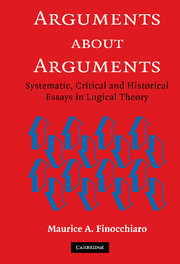Book contents
- Frontmatter
- Contents
- Preface and Acknowledgments
- Introduction : An Approach to a Branch of Logic
- Theorizing about reasoning and argument
- Fallacies and asymmetries
- 6 Fallacies and the Evaluation of Reasoning (1981)
- 7 Six Types of Fallaciousness : Toward a Realistic Theory of Logical Criticism (1987)
- 8 Asymmetries in Argumentation and Evaluation (1992)
- 9 The Positive versus the Negative Evaluation of Arguments (1994)
- Critiques
- Historical analyses
- Selected Bibliography
- Index
7 - Six Types of Fallaciousness : Toward a Realistic Theory of Logical Criticism (1987)
from Fallacies and asymmetries
Published online by Cambridge University Press: 05 February 2015
- Frontmatter
- Contents
- Preface and Acknowledgments
- Introduction : An Approach to a Branch of Logic
- Theorizing about reasoning and argument
- Fallacies and asymmetries
- 6 Fallacies and the Evaluation of Reasoning (1981)
- 7 Six Types of Fallaciousness : Toward a Realistic Theory of Logical Criticism (1987)
- 8 Asymmetries in Argumentation and Evaluation (1992)
- 9 The Positive versus the Negative Evaluation of Arguments (1994)
- Critiques
- Historical analyses
- Selected Bibliography
- Index
Summary
Like Mt. Everest and the moon, fallacies are challenging simply because they exist. Though it is not exactly true that if they did not exist someone would have to invent them, they do seem to possess the uncanny power deriving from the principle that likes attract each other, and so a number of authors have recently complained about such things as “the fallacy behind fallacies” (Massey 1981a), the prevalence of “some fallacies about fallacies” (Grootendorst 1987), and “how philosophers' charges of fallacy are often themselves fallacious” (Finocchiaro 1981, 22).
Be that as it may, the phenomenon of error in general, and of fallacies in particular, is too much a part of the human condition for us to give up the study of them simply because this study, like any other human activity, is itself liable to error and to fallacy. So, instead of trying to articulate and classify the various errors (be they actual, potential, or imaginary) that characterize the study of fallacies, it is preferable to begin by briefly mentioning a number of approaches that are possible and that are to some extent followed by different scholars. This is especially true in the present context, where the only appropriate attitude is one of live and let live.
Methodological Considerations
It is useful to distinguish three main approaches to the study of fallacies, the third being the one to be pursued here.
- Type
- Chapter
- Information
- Arguments about ArgumentsSystematic, Critical, and Historical Essays In Logical Theory, pp. 128 - 147Publisher: Cambridge University PressPrint publication year: 2005



